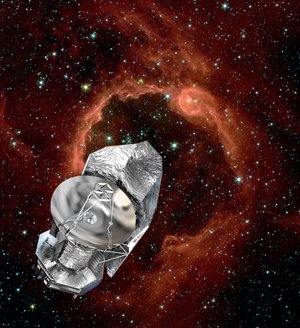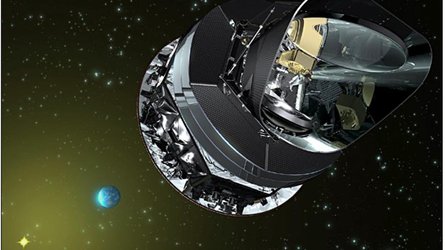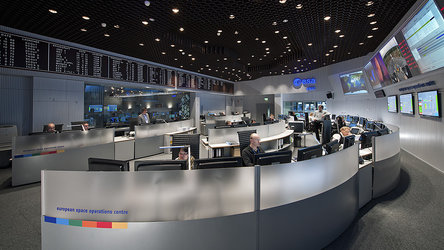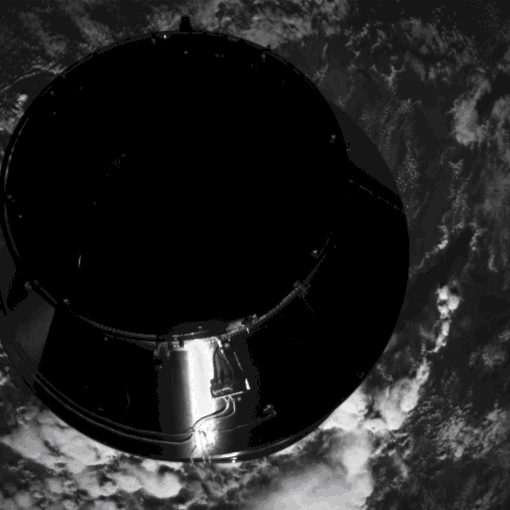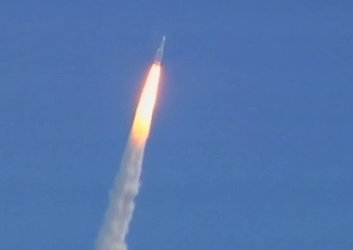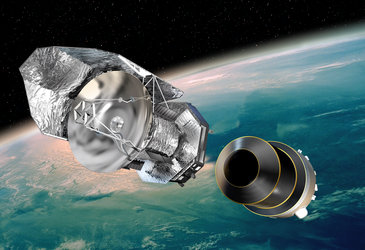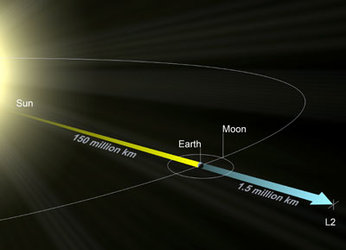Planck satellite manoeuvre aims at L2 arrival
Beginning today, ESA's Planck satellite will carry out a critical mid-course manoeuvre that will place the satellite on its final trajectory for arrival at L2, the second Lagrange point of the Sun-Earth system, early in July.
The manoeuvre is scheduled to begin at 19:28 CEST on 5 June 2009, and will last for up to 30 hours.
Planck's main thrusters will conduct repeated 'pulse burns' during this time, switching on then off for 6 seconds every minute.
This pulse-burn technique is necessary because Planck is slowly spinning as it travels through space, rotating at 1 rpm. The thrusters, which are fixed to the spacecraft and are not steerable, can only burn when they are oriented in the correct direction, which occurs for 6 seconds during each 60-second rotation.
Manoeuvre provides mid-course correction
The manoeuvre is expected to provide an overall change in speed of 550.8 km/hour. As of 5 June, Planck was travelling at a speed of 105 840 km/hour with respect to the Sun and was located 1.19 million km from Earth.
"Throughout the manoeuvre, we will closely monitor the spacecraft behaviour and its dynamical state. Once the manoeuvre is complete, sometime late on Saturday, the Flight Dynamics team will analyse the burn performance and determine Planck's new orbit. Based on the results, we also have a slot available for a 'touch-up' manoeuvre on 17 June," says Matthias Mück, Planck Flight Dynamics specialist at ESOC, ESA's European Space Operations Centre, in Darmstadt, Germany.
Mück says today's manoeuvre is programmed to slightly undershoot the actual desired end-speed, so the touch-up manoeuvre on 17 June will probably be necessary to provide a final 5- to 10-m/s correction.
Orbit insertion manoeuvre planned early July

After 17 June, the satellite will continue on the last leg of its journey to L2. A final major manoeuvre is planned for the first week in July to boost Planck into its operational orbit: a Lissajous orbit with an average amplitude of about 400 000 km around L2.
This weekend's critical activity will be conducted by the Planck Flight Control Team at ESOC, supported by Flight Dynamics specialists, industry representatives and other experts.
Named after the German Nobel laureate Max Planck (1858-1947), ESA's Planck mission is the first European space observatory whose main goal is the study of the Cosmic Microwave Background – the relic radiation from the Big Bang, with an accuracy defined by fundamental astrophysical limits.















 Germany
Germany
 Austria
Austria
 Belgium
Belgium
 Denmark
Denmark
 Spain
Spain
 Estonia
Estonia
 Finland
Finland
 France
France
 Greece
Greece
 Hungary
Hungary
 Ireland
Ireland
 Italy
Italy
 Luxembourg
Luxembourg
 Norway
Norway
 The Netherlands
The Netherlands
 Poland
Poland
 Portugal
Portugal
 Czechia
Czechia
 Romania
Romania
 United Kingdom
United Kingdom
 Slovenia
Slovenia
 Sweden
Sweden
 Switzerland
Switzerland

























